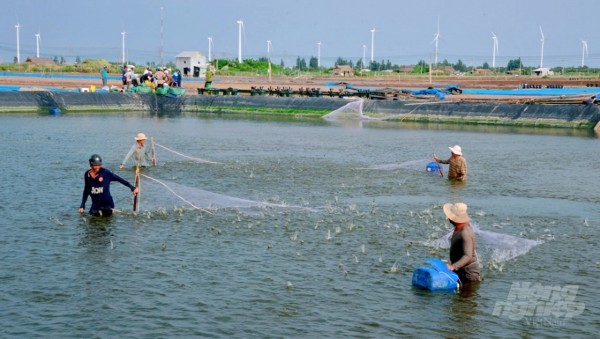November 26, 2025 | 01:46 GMT +7
November 26, 2025 | 01:46 GMT +7
Hotline: 0913.378.918
November 26, 2025 | 01:46 GMT +7
Hotline: 0913.378.918
At the conference, Deputy Minister of Agriculture and Rural Development Phung Duc Tien emphasized: Under the pressure of waste pollution, the pollution in the farming and livestock sectors is extremely serious. Therefore, it is particularly crucial to implement the prevention of aquatic diseases.
Developing a national aquatic disease prevention plan, and conducting that national plan to prevent aquatic diseases for the period 2021-2025 is an urgent task for the fisheries sector.
In the first 10 months of 2020, more than 41,980 hectares of aquaculture areas were damaged, which is 1.91 times higher than the same period in 2019. Brackish water shrimp farming was the most damaged with more than 39,000 hectares, said Mr. Nguyen Van Long, Deputy Director of the Department of Animal Health.
In addition, more than 1,000 hectares of pangasius have been destroyed, which accounts for an increase of 16.46 times over the same period last year. Acute hepatopancreatic necrosis disease, white spots, red body, white feces, intestinal were reported as the main diseases in brackish water shrimp... Meanwhile, liver, kidney disease, parasitic diseases have become threats to pangasius industry. Accordingly, the general and specific goals for the national plan to prevent dangerous aquatic diseases in the next 5 years should be focused on the prevention of dangerous diseases on some key aquatic products including shrimp, pangasius, lobster, salmon, tilapia, and clam.
The specific goals include: controlling the rate of infected areas under 3% of the total farming areas; actively monitoring dangerous pathogens that cause serious illness, epidemiological mapping of diseases distribution; effectively preventing new dangerous diseases; improving the quality of aquatic diseases control and prevention; and building at least five disease-free chains of shrimp and pangasius.
This draft plan will be consulted for finalization before MARD’s submission to the Prime Minister to issue a Decision applied for the next 5-year period.

Agricultural Service Centers have been established in some provinces, which broke the veterinary system’s operation. Photo: Le Hoang Vu.
To manage the aquatic disease situation, the Department of Animal Health and Department of Livestock Production should develop an annual plan for training and information dissemination to local veterinary staff and aquatic farmers. Every year, the samples of aquatic products should be collected for disease testing as of given regulations, so as to enhance the monitoring of resources of aquatic farming. Dangerous diseases such as viral diseases in brackish water shrimp and white spots in the internal organs should be controlled, Deputy Director of Can Tho Department of Agriculture and Rural Development Pham Truong Yen commented.
Deputy Minister Phung Duc Tien highly appreciated the preparation of the Department of Animal Health and the feedback of the local authorities. Some provinces have established the Agricultural Service Centers which broke the original veterinary service system’s operation. During this period, the Ministry of Agriculture and Rural Development has sent dispatches to provincial governments to suspend such establishment and even questioned the Minister of the Interior about this issue. It is expected that the veterinary system will be re-established. Currently, some provinces have re-established the veterinary system following veterinary law.
Author: Ngoc Thang - Hoang Vu. Translated by Meagan Phan. Edited by Duc Huy.
/2025/11/24/3536-2-112800_176.jpg)
(VAN) Dong Nai now has tens of thousands of hectares of forests certified for sustainable management, and this area will continue to be expanded in the coming period.

(VAN) Vinh Ha hamlet (Dai Xuyen commune, Hanoi) is shifting away from small-scale farming as households adopt bioscurity into their breeder chicken models.

(VAN) Heavy rains make aquatic species more vulnerable to disease. Proactive water management and high-tech systems help farmers prevent outbreaks and protect yields.

(VAN) Greenhouses are shifting production mindsets in Binh Lu commune, enabling farmers to ‘weather the sun and rain’ and secure stable vegetable harvests throughout the year.

(VAN) Green transition is crucial for the Mekong Delta amid climate change and stricter standards, offering a path toward sustainability.

(VAN) Dong Thap promotes agricultural restructuring, forms large specialized farming zones, raises the value of agricultural products and develops toward ecological and high-tech directions.
/2025/11/22/4018-4-213342_747.jpg)
(VAN) The Mekong Delta Agricultural Experts Club has attracted 143 experts and researchers to participate in providing consultancy and contributing initiatives to the development of one million hectares of high-quality rice.